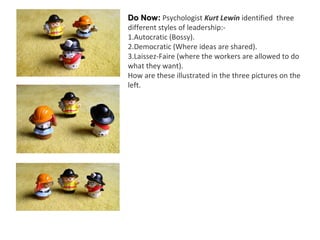1. leadership styles
- 1. Do Now:Do Now: Psychologist Kurt Lewin identified three different styles of leadership:- 1.Autocratic (Bossy). 2.Democratic (Where ideas are shared). 3.Laissez-Faire (where the workers are allowed to do what they want). How are these illustrated in the three pictures on the left.
- 2. Leadership Styles Psychologist Kurt Lewin set out to identify different styles of leadership. = 1. Autocratic Authoritarian leaders make decisions independently with little or no input from the rest of the group. Authoritarian leadership is best applied to situations where:- • There is little time for group decision- making • Where the leader is the most knowledgeable member of the group.
- 3. 2. Democratic Democratic leaders offer guidance to group members, but they also participate in the group and allow input from other group members. • Participative leaders encourage group members to participate, but retain the final say over the decision-making process. • Group members feel engaged in the process and are more motivated and creative.
- 4. 3. Laissez-Faire Laissez-Faire leaders offer little or no guidance to group members and leave decision- making up to group members. • While this style can be effective in situations where group members are highly qualified in an area of expertise, • it often leads to poorly defined roles and a lack of motivation.
- 5. Activity: What type of leadership style in each situation? Activity: What type of leadership style in each situation •Limited Time •Lack of respect between leader and workers •Employees are highly knowledgeable •Employees are poorly trained •Task is unstructured •No established procedures
- 6. Situational Leadership This is where Leaders adapt their style to different situations. Depends upon – CLOTS. 1.Culture of the Business 2.Leadership style of the leader 3.Organisation - Tall or flat 4.Task – Difficult, urgent or important 5.Subordinates – Skills, motivation.
- 7. Situational Leadership This is where Leaders adapt their style to different situations. Depends upon – CLOTS. 1.Culture of the Business 2.Leadership style of the leader 3.Organisation - Tall or flat 4.Task – Difficult, urgent or important 5.Subordinates – Skills, motivation.







